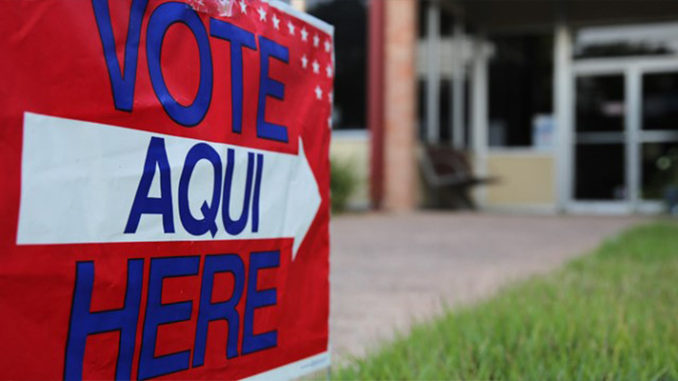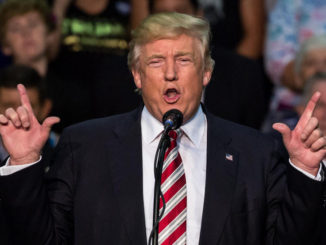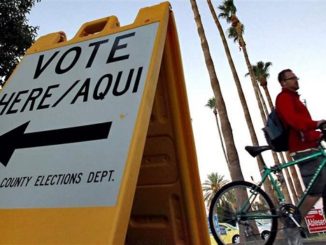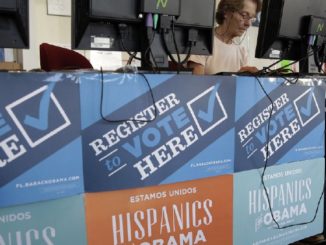
by Myra Adams
Those who follow politics know that the future is uncertain for an overwhelmingly white Republican Party, due to clear-cut demographic trends. Voters who identify with the GOP are more likely to be male, over age 50, have no college degree, live in rural areas, and worship as Christians.
I joined the College Republicans in the aftermath of Watergate when the GOP was also in decline. Yet, our handful of student members were optimistic that conservative governing principles would eventually prevail. In 1980, that is precisely what happened: Ronald Reagan was elected.
Forty years later, conservative governing principles are largely passé, and Republican gatherings resemble a focus group of aging white Americans. Moreover, in 2020 whites are projected to be 66.7% of the voting total, dipping from 70% in 2016 and down steeply from 88% in 1980.
In the last three presidential elections, the Republican nominees lost the popular vote but won the shrinking white electorate by sizable margins. Trump in 2016: 57% to 37%. Romney in 2012: 59% to 39%. McCain in 2008: 55% to 43%.
Turning to the current White House race, a recent national Fox News poll found a significant shift in white voters’ presidential preference. Among likely white voters, President Trump is leading Joe Biden 54% to 43%. But Biden’s campaign is celebrating that 11-point gap because, in 2016, Trump won whites by 20 percentage points over Hillary Clinton. If these Fox poll percentages hold, Trump’s nine-point decrease among two-thirds of the electorate will make it statistically challenging for him to win the popular vote and, more importantly, the Electoral College.
In the meantime, election reporting is fixated on the Hispanic vote, and for good reasons. This is the first election when Hispanics are projected to be the nation’s largest minority voting group, at 13.3% of the electorate, surpassing the projected 12.5% for African Americans.
Compare those percentages to 2016 when Hispanics were at 11%, just behind African Americans at 12%. (In 2008 and 2012, Barack Obama boosted African American participation to 13%, a record high.)
I vividly recall when the national Hispanic vote was only 7% around the turn of the century – and the mantra among anxious GOP strategists was “We can’t lose the Hispanic vote like we lost the black vote.” And in the next breath came some variation of “or we will go the way of the Whigs.” The strategists were fearful because “safe” red states such as Texas, Arizona, New Mexico, Nevada, Colorado, and Florida had growing numbers of Hispanic voters who were voting Democratic at 60% or more. Unfortunately for my party, the continuation of that trend is exactly what has happened.
Since around 2000, when the Hispanic vote started to gain traction, the Republican Party’s success in attracting this group has been dismal. Over 60% of Hispanics have voted for the Democrat presidential nominee in every presidential election starting with 1992, shown below with one sub-60% exception.
What follows are Hispanic presidential voting percentages since that year and their share of voting totals shown in parentheses.
2016: Clinton 66%-Trump 28% (11%)
2012: Obama 71%-Romney 27% (10%)
2008: Obama 67%-McCain 31% (9%)
2004: Kerry 53%-Bush 44% (7%)
2000: Gore 62%-Bush 35% (7%)
1996: Clinton (record holder) 73%-Dole 21% (5%)
1992: Clinton 61%-Bush 25% (2%)
Currently there are numerous reports about how Biden is not attracting Hispanic voters compared to previous Democratic incumbents and nominees — especially Hillary Clinton. Therefore, the Trump campaign should be encouraged since numerous polls, such as the one cited earlier from Fox News, show that among likely Hispanic voters, Trump is earning 41% compared to 57% for Biden. (Remember that nationally in 2016, Trump only won 28% of Hispanics.)
But among registered Hispanic voters, the Fox poll shows Trump dipping to 38% with the same 57% for Biden. In a national You/Gov poll, again measuring registered Hispanic voters, Trump sinks to 30% with 52% for Biden and 12% “not sure.”
Next, let’s look at battleground Florida, where it is almost imperative that the president win the state’s 29 electoral votes if he hopes to secure a second term. Last week a St. Pete poll of likely voters had Biden winning the Hispanic vote 53.3% to Trump’s 41.5%.
This week, a Monmouth poll of registered voters shows Biden leading Trump among Florida’s Hispanics 58% to 32%. To compare, in 2016 Clinton lost the state to Trump by 1.2 percentage points, but won Florida’s diverse Hispanic vote 62% to 35%. So this survey is not good news for either candidate since both are down from 2016 percentages, but Trump’s deficit of 26 points mirrors his gap four years ago.
Now let’s examine the 2020 battleground states through the lens of 2016 Hispanic voting by party along with their percentage of the state’s voting total. Note that the states listed below are likely to increase their percentage of Hispanic voters by about two points or more this year. The states selected are all “toss-ups,” according to the RealClearPolitics 2020 Electoral College map and presented in order of the largest Hispanic electorate.
Texas: (D) 61% (R) 34% (24%)
Florida: (D) 62% (R) 35% (18%)
Nevada: (D) 60% (R) 29% (18%)
Arizona: (D) 60% (R) 30% (16%)
Pennsylvania: (D) 74% (R) 22% (6%)
Michigan: (D) 59% (R) 38% (5%)
North Carolina: (D) 59% (R) 39% (5%)
Wisconsin: (D) 63% (R) 34% (4%)
Ohio: (D) 68% (R 28%) (3%)
All we know for sure in mid-September is that 2020 will be another step up for the growing Hispanic electorate’s clout in close battleground states and, ultimately, the national election.
Circling back to the GOP’s “losing the Hispanic vote” mantra of decades ago, there was much discussion about how Hispanics “should be Republicans.” The thinking was that, in general, Hispanics are conservative, family-oriented, and religious, with many starting and owning businesses. However, in the ensuing years, this bloc has remained in the Democrat fold, likely because of immigration issues and “not feeling welcome” in the GOP.
By now, their two-thirds support for Democrats is a well-established voting pattern. That, combined with Asian voters also trending toward Democrats, the shrinking (and always split) white vote, and African Americans virtually in lockstep with Democrats, suggests a daunting long-term future for the Republican Party. But I remind myself that after President Ford’s 1976 election loss, I had the same thought.
Of course, there is always the possibility that a GOP presidential candidate will emerge who “looks like the new America.” Already, three prominent Republicans come to mind, but let’s save that discussion for after November.



